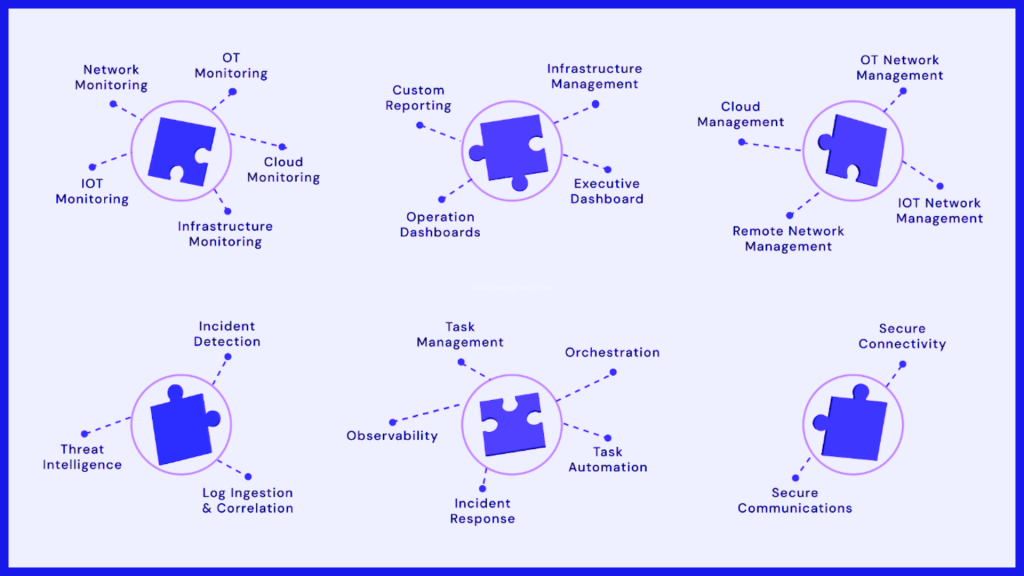Too Many Tools? One Unique Platform to Command and Control Them All.


Raj Meghani
Co-Founder, CMO & Head of Product & Sales
Complexity isn’t just inconvenient – it’s dangerous.
Today we are driven by real-time data, hyperconnectivity, and an expanding digital perimeter, cybersecurity has never been more critical – nor more complex.
The average enterprise uses between 70 – 90 cybersecurity tools across different platforms, vendors, and consoles. That’s not just fragmented – it’s chaotic.
- Security teams are drowning in alerts.
- Operations are fractured.
- Response times are slow.
- Visibility is partial at best.
And in that fog of tools, dashboards, and toggles – cyber threats slip through the cracks.
But what if you could orchestrate your entire digital ecosystem from one command centre – without having to toggle between different vendor applications, tools or platforms? And I’m not just thinking about security tools here – think wider. Operational Technologies (OT), Internet of Things (IoT), Multi-Functional Devices, ERP, CRM….you get the drift.
Welcome to BlockAPT’s centralised management platform — the cyber command centre that brings visibility, clarity, control, and cohesion to your entire security operation.
The Hidden Cost of Fragmented Security Management.
While most organisations invest heavily in security tools and face unprecedented cybersecurity challenges, here’s the twist: tool sprawl is sabotaging your security more than the threats you’re trying to defend against. Many of those challenges aren’t external threats – they’re internal complexity.
The sheer number of point solutions across a typical enterprise security stack is staggering – and rising. A Gartner 2024 report has found that ‘Only 14% of security leaders can effectively secure organisational data assets while also enabling the use of data to achieve business objectives’.
The implications are severe:
Alert Overload → Analyst Burnout.
Security teams are buried under an avalanche of alerts from dozens of tools – each one screaming for attention. Without centralised filtering, normalisation, or prioritisation, analysts chase false positives while real threats go undetected.
Too many tools. Too many consoles. Too many conflicting alerts. Analysts spend more time switching dashboards than stopping breaches.
According to IDC, 83% of cybersecurity employees say they’re struggling to cope with the overwhelming alert volume. Meanwhile, 30% of alerts are ignored or go un-investigated due to security teams of all sizes struggling with alert fatigue, leaving the door open to potential threats that can adversely affect the organisation.
This not only increases cyber breach risk but drives SOC burnout, employee churn, and operational fatigue.
Visibility Chaos → Delayed Responses.
When analysts need to jump between 10 different dashboards to investigate a single incident, response times suffer. Key threat signals get lost in translation between platforms.
You don’t have to be a rocket scientist to figure out that the more security tools and organisations have to manage, the higher the average MTTR (Mean Time To Respond) will be.
This fragmentation forces SOC teams to react slower, escalate more, and operate inefficiently under pressure.
Policy Drift → Security Gaps.
Each vendor’s toolset comes with its own policy syntax, update cadence, and user permissions model. Without consistent, centralised oversight, policies diverge over time—leading to:
- Unpatched systems
- Over-permissive access
- Redundant or contradictory rules
- Compliance violations (e.g. GDPR, NIS2, HIPAA, DORA)
These silent drifts create hidden vulnerabilities that nefarious attackers love to exploit.
Data Silos → No Big Picture
Even the most advanced tools lose their effectiveness when working in isolation. A firewall might detect suspicious traffic. A SIEM might see a strange login. But without correlation, no single tool can connect the dots.
Cloud/Multi-Cloud, On-prem, SaaS, IoT, etc – each environment demands different tools, each managed in isolation. This creates blind spots and inefficiencies in threat response.
I am a strong believer in that fragmented visibility is equal to fragmented security.
This siloed approach blinds CISOs and security leaders from understanding what’s really happening across the enterprise, making strategic decisions based on limited or outdated data.
Vendor Spaghetti.
Multiple tools from different vendors require overlapping licensing, integration services, expensive professional services and support contracts.
Let’s face it – the reality is every vendor has its own UI, policy engine, update cadence, and integration challenges. The result? Inconsistent security controls and policy drift across your architecture.
This leads to:
- Unnecessary financial overhead
- Budget bloat with diminishing returns
- Locked-in dependencies with no way to evolve
It’s a paradox: More tools, less control. More spend, less security.
Lack of Strategic Visibility:
Without a central view, CISOs and IT leaders can’t see the big picture. Decisions become reactive, not strategic.
BlockAPT: One Interface. Total Command. Zero Compromise.
The BlockAPT Platform flips the script and has been designed from the ground up to break the cycle of complexity. Instead of adding another tool to the noise, it becomes the intelligent layer that unifies your existing tools – regardless of vendor, environment, or deployment model. It’s the platform of platforms.
Here’s how:
A Single Pane of Glass for All Cyber Operations.
From SIEM to SOAR, firewall to endpoint, and cloud security to access control – the BlockAPT Platform integrates natively using Application Programming Interfaces (APIs) with all major vendors and tool categories. Through our unified interface, you can:
- Gain full-spectrum unified visibility across cloud, on-prem, and hybrid environments
- Trigger response playbooks across multiple systems with one click
- See customisable dashboards tailored by role – CISO, SOC analyst, IT admin, etc.
- Drill into alerts, behaviour patterns, and reports without leaving the platform
You don’t replace your stack – you command and control it better.
Real Time Cross-Tool Orchestration Engine.
The BlockAPT Platform acts as your security intelligence layer, fusing data from all connected tools.
The platform’s orchestration layer integrates natively with a wide array of cybersecurity tools – EDR, Public and Private Clouds, Firewalls, SIEM, SOAR, and more. Whether it’s Palo Alto, Microsoft Defender, Cisco, AWS Shield, Oracle Cloud, Azure Cloud, AWS Cloud, Google Cloud or Fortinet – we bring them together into one cohesive flow.
Our AI-powered analytics engine identifies patterns across multiple tools, so what might look like a low-priority alert in one system could trigger a high-severity event once correlated across others.
Our powerful analytics engine:
- Correlates alerts and logs in real time
- Flags anomalies only when they exceed risk thresholds across multiple layers
- Eliminates alert duplication and noise
- Provides confidence scoring for faster decision-making
The BlockAPT Platform’s correlation engine is what turns fragmented data into actionable insights.
Unified Policy Management and Role Based Controls.
Define security policies once – enforce them everywhere. You no longer have to deal with siloed configurations and ‘hope it’s consistent’ when conducting policy checks. .
Administrators, analysts, and SOC managers get tailored views and permissions, enabling precise control and compliance adherence.
With the BlockAPT Platform:
- Apply updates simultaneously across endpoint, networks, and cloud infrastructures
- Maintain strict compliance posture with automated audit trails
- Utilise granular levels of Role-Based Access Control (RBAC) and escalation paths
- Track policy drift and take corrective action proactively
AI Powered Playbooks Across the Entire Stack.
Whether you’re responding to a phishing attack, patching critical systems, or isolating a compromised endpoint, the BlockAPT Platform lets you utilise Out-Of-The-Box playbooks or build customised automated AI-powered workflows that execute across your infrastructure, not just within one solution.
- User friendly ‘drag and drop’ build for playbooks
- Auto-remediation for low-severity alerts
- Human-in-the-loop (change control) review for critical threats
- Adaptive workflows based on asset criticality
The Strategic Payoff: Visibility That Drives Action.
For executives and boards, the BlockAPT Platform transforms technical chaos into decision-ready clarity, providing a more proactive, strategic approach:
- Centralised management and control with unified visibility and customisable dashboards in one place
- Faster MTTD (Mean Time to Detect) and MTTR (Mean Time to Response) times
- Lower risk of misconfiguration and human error with automation powered by AI
- Real-time threat posture and reporting
- Stronger compliance reporting with auditable trails
- Higher ROI on existing security investments
The Bottom Line: You Don’t Need More Tools – You Need Smarter Command and Control
I believe in the “Built In not Bolt On” approach. In a fragmented, fast-moving threat landscape – especially with the increasing threats we see with AI based attacks, cybersecurity success comes not from volume – but from unified visibility, central management, orchestration, and speed.
I don’t believe organisations need more tools. They need smarter command and control.
The BlockAPT Platform offers exactly that. Total command and control – with zero compromise.
For more information or to request a trial of the BlockAPT platform, please visit our website: www.blockapt.com or book a meeting with us here.